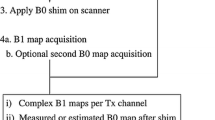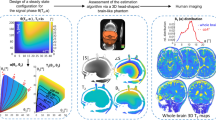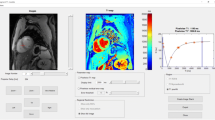Abstract
Objectives
The strategically acquired gradient echo (STAGE) protocol, developed for 3T scanners, allows one to derive quantitative maps such as T1, T2*, proton density, and quantitative susceptibility mapping in about 5 min. Our aim was to adapt the STAGE sequences for 1.5T scanners which are still commonly used in clinical practice. Furthermore, the accuracy and repeatability of the STAGE-derived T1 estimate were tested.
Methods
Flip angle (FA) optimization was performed using a theoretical simulation by maximizing signal-to-noise ratio, contrast-to-noise ratio, and T1 precision. The FA choice was further refined with the ISMRM/NIST phantom and in vivo acquisitions. The accuracy of the T1 estimate was assessed by comparing STAGE-derived T1 values with T1 maps obtained with an inversion recovery sequence. T1 accuracy was investigated for both the phantom and in vivo data. Finally, one subject was acquired 10 times once a week and a group of 27 subjects was scanned once. The T1 coefficient of variation (COV) was computed to assess scan-rescan and physiological variability, respectively.
Results
The FA1,2 = 7°,38° were identified as the optimal FA pair at 1.5T. The T1 estimate errors were below 3% and 5% for phantom and in vivo measurements, respectively. COV for different tissues ranged from 1.8 to 4.8% for physiological variability, and between 0.8 and 2% for scan-rescan repeatability.
Conclusion
The optimized STAGE protocol can provide accurate and repeatable T1 mapping along with other qualitative images and quantitative maps in about 7 min on 1.5T scanners. This study provides the groundwork to assess the role of STAGE in clinical settings.
Key Points
• The STAGE imaging protocol was optimized for use on 1.5T field strength scanners.
• A practical STAGE protocol makes it possible to derive quantitative maps (i.e., T1, T2*, PD, and QSM) in about 7 min at 1.5T.
• The T1 estimate derived from the STAGE protocol showed good accuracy and repeatability.






Similar content being viewed by others
Abbreviations
- CN:
-
Caudate nucleus
- CNR:
-
Contrast-to-noise ratio
- COV:
-
Coefficient of variation
- DR:
-
Dynamic range
- FA:
-
Flip angle
- FS:
-
Fractional signal
- GM:
-
Gray matter
- GP:
-
Globus pallidum
- HV:
-
Healthy volunteers
- MRI:
-
Magnetic resonance image
- PD:
-
Proton density
- PUT:
-
Putamen
- QSM:
-
Quantitative susceptibility mapping
- ROI:
-
Region of interest
- SAR:
-
Specific absorption rate
- SNR:
-
Signal-to-noise ratio
- STAGE:
-
STrategically Acquired Gradient Echo
- SWI:
-
Susceptibility-weighted imaging
- TE:
-
Echo time
- THA:
-
Thalamus
- TI:
-
Inversion time
- TR:
-
Repetition time
- WM:
-
White matter
References
Deoni SC, Peters TM, Rutt BK (2005) High-resolution T1 and T2 mapping of the brain in a clinically acceptable time with DESPOT1 and DESPOT2. Magn Reson Med 53:237–241
Deoni SC, Rutt BK, Peters TM (2003) Rapid combined T1 and T2 mapping using gradient recalled acquisition in the steady state. Magn Reson Med 49:515–526
Ma D, Gulani V, Seiberlich N et al (2013) Magnetic resonance fingerprinting. Nature 495:187–192
Tang J, Liu S, Neelavalli J, Cheng YC, Buch S, Haacke EM (2013) Improving susceptibility mapping using a threshold-based K-space/image domain iterative reconstruction approach. Magn Reson Med 69:1396–1407
Filippi M, Rocca MA, Ciccarelli O et al (2016) MRI criteria for the diagnosis of multiple sclerosis: MAGNIMS consensus guidelines. Lancet Neurol 15:292–303
Kurki T, Komu M (1995) Spin-lattice relaxation and magnetization transfer in intracranial tumors in vivo: effects of Gd-DTPA on relaxation parameters. Magn Reson Imaging 13:379–385
Liu S, Buch S, Chen Y et al (2017) Susceptibility-weighted imaging: current status and future directions. NMR Biomed 30
Tofts P (2005) Quantitative MRI of the brain: measuring changes caused by disease. John Wiley & Sons, Hoboken
Wingerchuk DM, Carter JL (2014) Multiple sclerosis: current and emerging disease-modifying therapies and treatment strategies. Mayo Clin Proc 89:225–240
Chen Y, Liu S, Buch S, Hu J, Kang Y, Haacke EM (2018) An interleaved sequence for simultaneous magnetic resonance angiography (MRA), susceptibility weighted imaging (SWI) and quantitative susceptibility mapping (QSM). Magn Reson Imaging 47:1–6
Liu M, Liu S, Ghassaban K et al (2016) Assessing global and regional iron content in deep gray matter as a function of age using susceptibility mapping. J Magn Reson Imaging 44:59–71
Bonnier G, Marechal B, Fartaria MJ et al (2017) The combined quantification and interpretation of multiple quantitative magnetic resonance imaging metrics enlightens longitudinal changes compatible with brain repair in relapsing-remitting multiple sclerosis patients. Front Neurol 8:506
Eminian S, Hajdu SD, Meuli RA, Maeder P, Hagmann P (2018) Rapid high resolution T1 mapping as a marker of brain development: Normative ranges in key regions of interest. PLoS One 13:e0198250
Saito N, Sakai O, Ozonoff A, Jara H (2009) Relaxo-volumetric multispectral quantitative magnetic resonance imaging of the brain over the human lifespan: global and regional aging patterns. Magn Reson Imaging 27:895–906
Gracien RM, Jurcoane A, Wagner M et al (2016) Multimodal quantitative MRI assessment of cortical damage in relapsing-remitting multiple sclerosis. J Magn Reson Imaging 44:1600–1607
Manfredonia F, Ciccarelli O, Khaleeli Z et al (2007) Normal-appearing brain t1 relaxation time predicts disability in early primary progressive multiple sclerosis. Arch Neurol 64:411–415
Stevenson VL, Parker GJ, Barker GJ et al (2000) Variations in T1 and T2 relaxation times of normal appearing white matter and lesions in multiple sclerosis. J Neurol Sci 178:81–87
Jiang Y, Ma D, Seiberlich N, Gulani V, Griswold MA (2015) MR fingerprinting using fast imaging with steady state precession (FISP) with spiral readout. Magn Reson Med 74:1621–1631
Wu D, Liu S, Buch S, Ye Y, Dai Y, Haacke EM (2016) A fully flow-compensated multiecho susceptibility-weighted imaging sequence: the effects of acceleration and background field on flow compensation. Magn Reson Med 76:478–489
Leporq B, Lambert SA, Ronot M, Vilgrain V, Van Beers BE (2017) Simultaneous MR quantification of hepatic fat content, fatty acid composition, transverse relaxation time and magnetic susceptibility for the diagnosis of non-alcoholic steatohepatitis. NMR Biomed 30:e3766
Metere R, Kober T, Moller HE, Schafer A (2017) Simultaneous quantitative MRI mapping of T1, T2* and magnetic susceptibility with multi-echo MP2RAGE. PLoS One 12:e0169265
Liao C, Bilgic B, Manhard MK et al (2017) 3D MR fingerprinting with accelerated stack-of-spirals and hybrid sliding-window and GRAPPA reconstruction. Neuroimage 162:13–22
Chen Y, Liu S, Wang Y, Kang Y, Haacke EM (2018) STrategically Acquired Gradient Echo (STAGE) imaging, part I: creating enhanced T1 contrast and standardized susceptibility weighted imaging and quantitative susceptibility mapping. Magn Reson Imaging 46:130–139
Wang Y, Chen Y, Wu D et al (2018) STrategically Acquired Gradient Echo (STAGE) imaging, part II: correcting for RF inhomogeneities in estimating T1 and proton density. Magn Reson Imaging 46:140–150
Haacke EM, Chen Y, Utriainen D et al (2020) STrategically Acquired Gradient Echo (STAGE) imaging, part III: technical advances and clinical applications of a rapid multi-contrast multi-parametric brain imaging method. Magn Reson Imaging 65:15–26
Wang Y, Huang F, Xu W et al (2018) STAGE imaging at 1.5T: a rapid brain protocol providing more images as well as quantitative data. Int Soc Magn Res Med Scientific Meeting Proceedings 2750
Griffanti L, Baglio F, Preti MG et al (2012) Signal-to-noise ratio of diffusion weighted magnetic resonance imaging: estimation methods and in vivo application to spinal cord. Biomed Signal Process Control 7:285–294
Smith SM (2002) Fast robust automated brain extraction. Hum Brain Mapp 17:143–155
Smith SM, Zhang Y, Jenkinson M et al (2002) Accurate, robust, and automated longitudinal and cross-sectional brain change analysis. Neuroimage 17:479–489
Steenwijk MD, Vrenken H, Jonkman LE et al (2016) High-resolution T1-relaxation time mapping displays subtle, clinically relevant, gray matter damage in long-standing multiple sclerosis. Mult Scler 22:1279–1288
Allison J, Yanasak N (2015) What MRI sequences produce the highest specific absorption rate (SAR), and is there something we should be doing to reduce the SAR during standard examinations? AJR Am J Roentgenol 205:W140
Look DC, Locker DR (1970) Time saving in measurement of NMR and EPR relaxation times. Rev Sci Instrum 41:250–251
Barral JK, Gudmundson E, Stikov N, Etezadi-Amoli M, Stoica P, Nishimura DG (2010) A robust methodology for in vivo T1 mapping. Magn Reson Med 64:1057–1067
Cabana JF, Gu Y, Boudreau M et al (2015) Quantitative magnetization transfer imaging made easy with q MTL ab: software for data simulation, analysis, and visualization. Concepts Magn Reson Part A 44:263–277
Jenkinson M, Bannister P, Brady M, Smith S (2002) Improved optimization for the robust and accurate linear registration and motion correction of brain images. Neuroimage 17:825–841
Patenaude B, Smith SM, Kennedy DN, Jenkinson M (2011) A Bayesian model of shape and appearance for subcortical brain segmentation. Neuroimage 56:907–922
Everitt B (1998) The Cambridge dictionary of statistics Cambridge University Press. UK Google Scholar, Cambridge
Gasparovic C, Neeb H, Feis DL et al (2009) Quantitative spectroscopic imaging with in situ measurements of tissue water T1, T2, and density. Magn Reson Med 62:583–590
Rooney WD, Johnson G, Li X et al (2007) Magnetic field and tissue dependencies of human brain longitudinal 1H2O relaxation in vivo. Magn Reson Med 57:308–318
Steen RG, Gronemeyer SA, Kingsley PB, Reddick WE, Langston JS, Taylor JS (1994) Precise and accurate measurement of proton T1 in human brain in vivo: validation and preliminary clinical application. J Magn Reson Imaging 4:681–691
Warntjes JB, Leinhard OD, West J, Lundberg P (2008) Rapid magnetic resonance quantification on the brain: optimization for clinical usage. Magn Reson Med 60:320–329
Zhu DC, Penn RD (2005) Full-brain T1 mapping through inversion recovery fast spin echo imaging with time-efficient slice ordering. Magn Reson Med 54:725–731
Crawley AP, Henkelman RM (1988) A comparison of one-shot and recovery methods in T1 imaging. Magn Reson Med 7:23–34
Graumann R, Deimling M, Heilmann T, Oppelt A (1986) A new method for fast and precise T1 determination. Proceedings of the Society of Magnetic Resonance in Medicine, pp 922–923
Haase A (1990) Snapshot FLASH MRI. Applications to T1, T2, and chemical-shift imaging. Magn Reson Med 13:77–89
Haase A, Matthaei D, Bartkowski R, Duhmke E, Leibfritz D (1989) Inversion recovery snapshot FLASH MR imaging. J Comput Assist Tomogr 13:1036–1040
Acknowledgments
The multi-echo SWI sequence was provided by Prof. Yongsheng Chen and Prof. Mark Haacke in collaboration with SIEMENS Healthineers with a C2P agreement.
Funding
This study has received funding by the Italian Ministry of Health (Ricerca Corrente and Rete IRCCS delle Neuroscienze e della Neuroriabilitazione - Neuroimaging).
Author information
Authors and Affiliations
Corresponding author
Ethics declarations
Guarantor
The scientific guarantor of this publication is Dr. Maria Marcella Laganà.
Conflict of interest
Dr. Haacke works for SpinTech who owns the license for STAGE.
Statistics and biometry
No complex statistical methods were necessary for this paper.
Informed consent
Written informed consent was obtained from all subjects in this study.
Ethical approval
Institutional Review Board approval was obtained.
Methodology
prospective
observational
performed at one institution
Additional information
Publisher’s note
Springer Nature remains neutral with regard to jurisdictional claims in published maps and institutional affiliations.
Supplementary Information
ESM 1
(DOCX 498 kb)
Rights and permissions
About this article
Cite this article
Pirastru, A., Chen, Y., Pelizzari, L. et al. Quantitative MRI using STrategically Acquired Gradient Echo (STAGE): optimization for 1.5 T scanners and T1 relaxation map validation. Eur Radiol 31, 4504–4513 (2021). https://doi.org/10.1007/s00330-020-07515-z
Received:
Revised:
Accepted:
Published:
Issue Date:
DOI: https://doi.org/10.1007/s00330-020-07515-z




